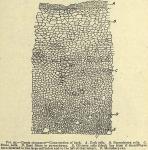Saigon cassia.
The dried bark of the stem and branches of an undetermined species of Cinnamo'mum.
DESCRIPTION OF DRUG.—It takes its name from Saigon, the capital of French Cochin-China, where it is collected and exported. It is in large quills or broken pieces, 1 or 2 mm. (1/25 to 1/12 in.) thick; the gray or grayish-brown bark, which is not removed, is more or less rough and warty, longitudinally wrinkled and ridged, and covered with whitish patches. Inner bark cinnamon-brown or dark brown, with numerous white striae near the bark; fracture short, granular; odor aromatic; taste aromatic and pungent. Ash, not exceeding 6 per cent.; not exceeding 2 per cent. insoluble in HCl.
COMPARISON OF THE CINNAMON BARKS.—
Color.—There is quite a difference in the depth of the color of the three barks. The Ceylon is the lightest, the Saigon is the darkest, and the Cassia intermediate. This difference in shade is shown best in the powder.
Thickness.—The Ceylon is very thin and papery. The Saigon, usually regarded as the thickest, is in the average about the same as Cassia.
Odor.—The odor and taste of the Saigon is the strongest, the Ceylon is the most delicate, the Cassia weakest.
 Microscopical.—To distinguish between the barks no difficulty is experienced in cross- and longitudinal sections, which display the oil-cells, stone cells, and other elements. In the powdered condition the Ceylon shows the largest stone cells. In Cassia the stone cells are less numerous and smaller. In the Saigon the oblong stone cells are about the same size as those of Cassia, but fewer in number.
Microscopical.—To distinguish between the barks no difficulty is experienced in cross- and longitudinal sections, which display the oil-cells, stone cells, and other elements. In the powdered condition the Ceylon shows the largest stone cells. In Cassia the stone cells are less numerous and smaller. In the Saigon the oblong stone cells are about the same size as those of Cassia, but fewer in number.
Powder.—Elements of: See Part iv, Chap. I, B.
- OFFICIAL PREPARATIONS.
- Tinctura Cardamomi Composita (2.5 per cent.), Dose: 1 to 3 fl. dr. (4 to 12 mils).
- Tinctura Gambir Composita (2.5 per cent.), ½ to 3 fl. dr. (2 to 12 mils).
- Tinctura Lavandulae Composita (2 per cent), ½ to 2 fl. dr. (2 to 8 mils).
- Tinctura Rhei Aromatica (4 per cent.), employed in Syrupus Rhei Aromaticus.
- Tinctura Cinnamomi (20 per cent.), ½ to 2 fl. dr. (2 to 8 mils). Employed also in Vinum Opii and Infusum Digitalis.
- Pulvis Aromaticus (35 per cent.), 15 gr. (1 Gm.)




